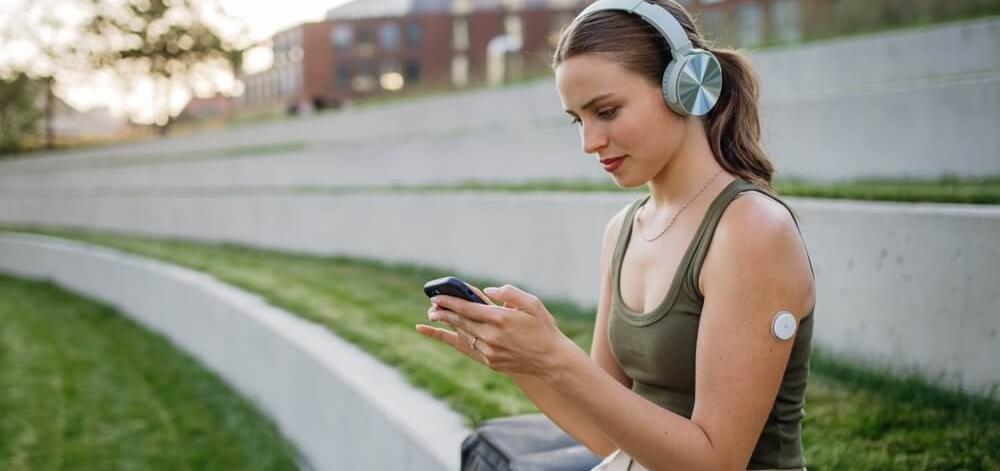
Continuous Glucose Monitoring (CGM) Basics
What Is a Continuous Glucose Monitor?
A continuous glucose monitor (CGM) is a small, wearable device that tracks blood sugar levels in real time.
CGMs use a tiny sensor placed under the skin to measure glucose in the fluid between cells. The sensor sends this data wirelessly to a smartphone or a small receiver, showing blood sugar trends and delivering alerts to help people manage diabetes more easily.
How Does a Continuous Glucose Monitor Work?
CGMs check blood sugar levels every few minutes, all day and night. This helps people see patterns to better understand their condition and how food, exercise, stress, and medication affect their glucose levels.
Many CGMs send alerts to warn people when their blood sugar is too high or too low, helping them avoid emergencies.
Who Should Consider Using a CGM?
Using a CGM may be especially helpful for:
- People with type 1 diabetes: A CGM is essential for managing insulin and preventing complications.
- People with type 2 diabetes who are on insulin: Continuous glucose monitoring helps fine-tune insulin doses and prevent blood sugar swings.
- Pregnant people with diabetes: Monitoring is important for keeping blood sugar stable during pregnancy.
- Anyone with diabetes who experiences frequent highs or lows: Monitoring can help if you don’t always feel blood sugar changes.
- Athletes or active people with diabetes: It can help to track how exercise affects your blood sugar.
Potential Benefits and Drawbacks of CGM
Benefits of using a CGM include:
- Fewer finger pricks: Since the sensor stays put, there’s no need for multiple daily blood tests.
- Real-time tracking: Users can see their glucose levels anytime, anywhere.
- Better diabetes control: Noticing patterns and trends can help people adjust their medication, food, and exercise to more effectively manage their condition.
- Warning alerts: Getting an alert can help someone take immediate steps to prevent dangerously high (hyperglycemia) or low blood sugar (hypoglycemia).
- Less stress: Around-the-clock monitoring may reduce worry about sudden blood sugar changes.
While CGMs are an important tool, they may have some drawbacks for some people, including:
- Cost: CGMs can be expensive, and not all insurance plans cover them.
- Skin irritation or sensor problems: Some people may have skin reactions or trouble keeping sensors in place.
- Information overload: Seeing blood sugar changes all day long can feel overwhelming to some people.
- Calibration needs: Some CGM devices require occasional finger pricks to assure accuracy.
- Learning curve: It can take time to get used to CGM alarms, sensor placement, and understanding the data the device provides.
Continuous Glucose Monitoring Devices: What to Look For
When choosing a CGM device, consider the accuracy, comfort, and ease of use. Other important features to consider are:
- How long the sensor lasts. Some sensors need to be changed every 10 to 14 days. Others last up to a year.
- Alerts and alarms. These notifications help you take steps to prevent dangerous blood sugar levels.
- Smartphone and app compatibility. Many people find that apps make tracking easier, and they allow for sharing with caregivers.
- Insulin pump integration. Some CGMs work with insulin pumps for automated insulin delivery.
Some popular CGM device options include:
- Dexcom G7: This device is very accurate, shares data in real time, and doesn’t require fingerstick calibration. Apple Watch users can see their info on their smartwatches.
- FreeStyle Libre 3: The Libre 3 has the smallest sensor available, no calibration is needed, and its app is easy to use.
- Medtronic Guardian Connect: This CGM system can predict highs and lows but requires occasional calibration.
- Eversense 365: The Eversense is designed for long-term use. The sensor is implanted under the skin by a healthcare professional and can stay put for a year.
Tips for Getting Used to a CGM
If you’re new to continuous glucose monitoring, there are some things you can do to make the adjustment easier.
Place the Sensor Correctly
Follow the instructions that come with your device for the best accuracy and comfort.
Start Slow
Simply observe how your blood sugar moves, without reacting to every change. Over time, you’ll get to know your body better by seeing your typical patterns and trends.
Use Adhesive Patches
Special patches can help keep the sensor in place and may be especially helpful if you're active.
Customize Alerts
Adjust alarm and notification settings so you avoid unnecessary notifications.
Talk to Your Doctor
Work with your healthcare provider to make changes based on the insights you gain by using your CGM device.
Want to Read More?
Access all of Dario Connect’s content, community, and experts for free!
Already a member? Login
Want to Read More?
Access all of Dario Connect’s content, community, and experts for free!
sign UP For FreeAlready a member? Login

